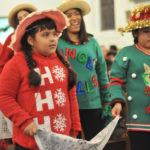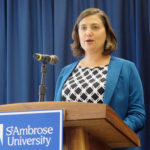
Ryan Saddler speaks during St. Ambrose University’s March to Remember – Silent March Jan. 23 in Davenport.
By Anne Marie Amacher
The Catholic Messenger
DAVENPORT — St. Ambrose College (now university) was the first Catholic college in the United States to form a campus NAACP chapter to engage Hispanics, African Americans and others in amplifying their voices, said Amy Novak, president of St. Ambrose.
She spoke to two dozen St. Ambrose University faculty, staff and students gathered Jan. 23 for the annual March to Remember – Silent March. Novak noted that St. Ambrose continues to strive to ensure that all voices can be heard and all lives are respected.
Father Ross Epping, chaplain, recited a prayer and the group marched silently around campus. During a stop in front of the flagpole outside Ambrose Hall, Ryan Saddler read from the 1951 booklet “Citizen Second Class,” which compiled survey results of African-Americans in the Davenport area. St. Ambrose College students conducted the survey in 1947 as an assignment for instructor Father William O’Connor.
Saddler, associate vice president for diversity, equity and inclusion at St. Ambrose, told the group, “Come, engage your imagination and take a time machine back to the post-WWII world. Where might you find a city where many had very little opportunity to participate in achieving the American dream? Was it because they didn’t want to or deserve to? Was it because they were born inferior? Or, was it because of something none of them had any control over?” He identified the hurdles:
Employment: Job choices were limited for African-Americans. “None could become school teachers or office workers or policemen or firemen. They could only have the worst possible jobs and even then they were usually the last hired and first fired.”
Housing: African-Americans knew where they could and could not live. Most of their residences were old and in various stages of disrepair. Basics such as furnaces, bathtubs and toilets were absent. Overcrowding was typical. An apartment complex might have two toilets in the building. The city did not enforce its own housing code. Real estate redlining, the practice of denying housing loans to credit-worthy applicants in certain neighborhoods, was widespread.
Health: A small number of doctors and dentists would accept African-American patients, and then “only after hours.”
Education: African-Americans had the good fortune to live in a state where K-12 public schools were integrated since 1868. The Catholic college for men and the Catholic college for women were integrated. Nursing programs were open to students of color. The chiropractic school and the business institute excluded them.
Public places and recreation: Publicly owned facilities and movie theaters were open to all. Outside of that, de facto segregation prevailed in the bowling alleys, downtown hotels and restaurants. Outside of the downtown, few restaurants and lunch counters served African-Americans.
Fraternal, veterans and civic organizations: Of the 12 fraternal organizations, six had explicit restrictions, one had no written policy, and the others claimed to welcome minority members but had none. Of the four veterans’ organizations, only one did not bar this minority, one had a separate minority organization, and the other two kept minorities out. Of the five civic organizations, only one expressed any desire to have minority members, but had none.
“So, where would you find such a city? Montgomery, Alabama? Tupelo, Mississippi?” Saddler asked. “Nope. Our story is about Blacks living in Davenport, Iowa…. Why are we here at the flagpole? It’s a sign to me,” Saddler said. It was a meeting spot for the Iowa Civil Rights movement. A march began at St. Ambrose and continued to St. Anthony Church downtown, then to the bandshell at LeClaire Park.
Saddler and the present-day marchers continued in silence to the Rogalski Center where Paul Koch, provost and vice president for academic and student affairs, shared some insights. While “St. Ambrose has a long history of marching silently, as in today or raising our voices in support of matters of justice, the history of this march is not that old.”
“It dates back to fall 2009, when Michael Dixon, coordinator of intercultural life and leadership programs at the time, sent a number of employees, student leaders and me a proposal for celebrating the legacy of Dr. Martin Luther King Jr. and the Civil Rights Movement in a new way at St. Ambrose. Included in the proposal was this march, which took place in the spring 2010 for the first time.”
“Michael’s vision was that this march was a time for individuals to turn off cell phones, pagers — yes, pagers were still in use in 2010 — and other devices so that this time could be spent in quiet reflection and prayerful remembrance of the civil rights movement and the legacy of Dr. Martin Luther King Jr.”
“So why do we continue this practice? As King said, ‘There are those who are asking the devotees of civil rights, when will you be satisfied?’ This march is an outward and visible sign of our inward passion and dedication to battle bigotry and oppression wherever it might be found. I pray we will continue to march and to stand up for the human dignitary of all people, both in our words and in our actions, and never be satisfied until it is truly no longer necessary.”











